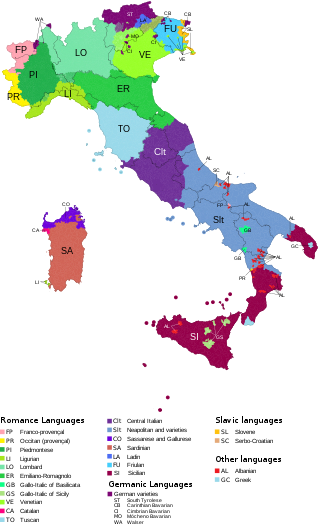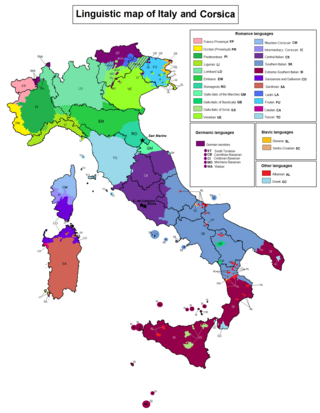Related Research Articles

Sardinian or Sard is a Romance language spoken by the Sardinians on the Western Mediterranean island of Sardinia.
The Camunic language is an extinct language that was spoken in the 1st millennium BC in Val Camonica, a valley in the Central Alps. The language is sparsely attested to an extent that makes any classification attempt uncertain – even the discussion of whether it should be considered a pre–Indo-European or an Indo-European language has remained indecisive. Among several suggestions, it has been hypothesized that Camunic is related to the Raetic language from the Tyrsenian language family, or to the Celtic languages.

Sicilian is a Romance language that is spoken on the island of Sicily and its satellite islands. It belongs to the broader Extreme Southern Italian language group.

The Lombard language belongs to the Gallo-Italic group within the Romance languages and is characterized by a Celtic linguistic substratum and a Lombardic linguistic superstratum and is a cluster of homogeneous dialects that are spoken by millions of speakers in Northern Italy and southern Switzerland, including most of Lombardy and some areas of the neighbouring regions, notably the far eastern side of Piedmont and the extreme western side of Trentino, and in Switzerland in the cantons of Ticino and Graubünden. The language is also spoken in Santa Catarina in Brazil by Lombard immigrants from the Province of Bergamo, in Italy.

The languages of Italy include Italian, which serves as the country's national language, in its standard and regional forms, as well as numerous local and regional languages, most of which, like Italian, belong to the broader Romance group. The majority of languages often labeled as regional are distributed in a continuum across the regions' administrative boundaries, with speakers from one locale within a single region being typically aware of the features distinguishing their own variety from one of the other places nearby.
The primary languages of Calabria are the Italian language as well as regional varieties of Extreme Southern Italian and Neapolitan languages, all collectively known as Calabrian. In addition, there are speakers of the Arbëresh variety of Albanian, as well as Calabrian Greek speakers and pockets of Occitan.

Giuliano Bonfante was an Italian linguist and expert on the language of the Etruscans and other Italic peoples. He was professor of linguistics at the University of Genoa and then at the University of Turin.

Gallo-Italic of Sicily, also known as the Siculo-Lombard dialects, is a group of Gallo-Italic languages found in about 15 isolated communities of central eastern Sicily. Forming a language island in the otherwise Sicilian language area, it dates back to migrations from northern Italy during the reign of Norman Roger I of Sicily and his successors.
Guido Romanelli was an Italian army officer.
The Consorzio ICoN is an interuniversity consortium for Italian Studies established in 1999. It consists of 21 Italian universities and focuses on philology and cultural studies. The consortium is based and administrated at the University of Pisa and is supported by the Italian Ministry of University and Research. It aims at diffusing Italian language, culture and literature.

Giacomo Devoto was an Italian historical linguist and one of the greatest exponents of the twentieth century of the discipline. He was born in Genoa and died in Florence.

Cadorino, a dialect of Ladin, is the language of Cadore, at the feet of the Dolomites in the province of Belluno. It is distinct from neighboring dialects, and though it has received relatively little attention, it is important to an understanding of the linguistic history of northern Italy.
Maurizio Trifone is an Italian linguist and lexicographer.
Francesco Altimari is an Italian scholar in the field of Albanology. He is honorary member of the Academy of Sciences of Albania (2006), external member of the Academy of Sciences and Arts of Kosovo (2008) and full professor (1991) of the Albanology section of the University of Calabria.
Pasquale Scutari is an Italian linguist and Albanologist.

Cademia Siciliana is a transnational non-profit organization founded in 2016 by a group of Sicilian language academics, activists, researchers, and students with the mission to promote the Sicilian language through education, research, and activism. The organization has published an orthographical proposal for the Sicilian language, and maintains several Sicilian language research and technology projects. Including translation and language advocacy projects for several popular applications and platforms such as Firefox, Telegram, Facebook and Android Keyboard. In 2021 the group gained attention for their collaboration with Google's Woolaroo, an augmented reality project intended to support regional and minority languages.
Sicilian orthography uses a variant of the Latin alphabet consisting of 23 or more letters to write the Sicilian language.
Maria Rita Manzini is Professor of Linguistics at the University of Florence. She is known for her work on syntax, syntactic variation, principles and parameters, the Romance languages, and the languages of the Balkans.

The Arianese dialect, typical of the territorial area of Ariano Irpino, is a vernacular variety of the Irpinian dialect, belonging in turn to the Neapolitan group of southern Italian dialects. Like all Romance languages, it descends directly from Vulgar Latin, a language of Indo-European stock that has been widespread in the area since Roman times.
References
- ↑ Marinella Lorinczi. "Lineamenti di storia grafematica della lingua romena (dalle origini fino al XXI secolo)" (PDF). Lineamenti di Storia Grafematica della Lingua Romena (Dalle Origini Fino al XXI Secolo). Università di Cagliari.
- ↑ Rosanna Cima; Rita Finco. "I fondamenti della lingua romena". Imparare e insegnare tra lingue diverse. La Scuola.
- ↑ "Enciclopedia Treccani - Ion Heliade Radulescu".
- ↑ Dan Octavian Cepraga. "L'occidentalizzazione romanza del romeno letterario: Heliade Rădulescu e la traduzione della Gerusalemme Liberata". Diacronia. Università degli Studi di Padova.
- ↑ "Ion Heliade Radulescu".
- ↑ Rotondi (2017 , pp. 47–62)
- ↑ Iorgu Iordan (1923–1928). "Dialectele italiene de sud şi limba română". Arhiva.
- ↑ Giovanni Alessi (1954). "Concordanze lessicali tra i dialetti rumeni e quelli calabresi". Annuario della Facoltà di Lettere e Filosofia di Bari.
- ↑ Ana-Maria Braitor (2017). "Unità e diversità nella marcatura differenziale dell'oggetto diretto in rumeno e in siciliano" (PDF). Tesi di Dottorato. Università degli Studi di Palermo.
- ↑ Ana-Maria Braitor (2017). "La teoria della Marcatura del Caso". Unità e diversità nella marcatura differenziale dell'oggetto diretto in rumeno e in siciliano. Unità e diversità nella marcatura differenziale dell'oggetto diretto in rumeno e in siciliano. Università degli Studi di Palermo: 17–21.
- 1 2 Ana-Maria Braitor (2017). "Il raddoppiamento clitico in rumeno e in siciliano". Unità e diversità nella marcatura differenziale dell'oggetto diretto in rumeno e in siciliano. Unità e diversità nella marcatura differenziale dell'oggetto diretto in rumeno e in siciliano. Università degli Studi di Palermo: 118–122.
- ↑ Federica D’Andrea, Carmela Lavecchia, Francesca Vittoria Russo, Carminella Scarfiello, Anna Maria Tesoro, Francesco Villone (2017). "I dialetti: patrimoni culturali locali nella lingua". Ianua. Revista Philologica Romanica. 17. Università degli Studi della Basilicata: 133–168.
{{cite journal}}: CS1 maint: multiple names: authors list (link)